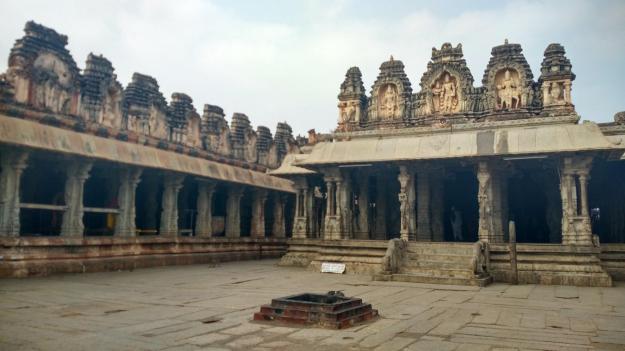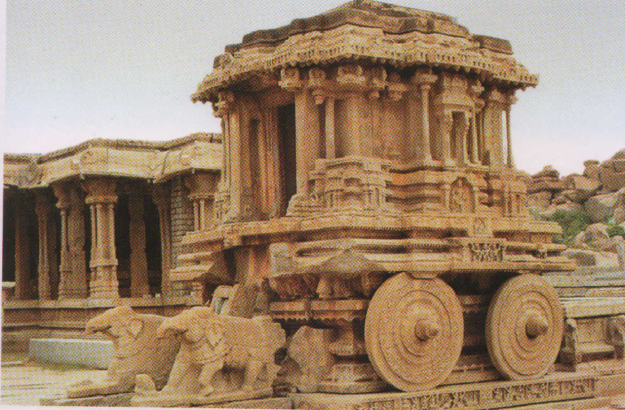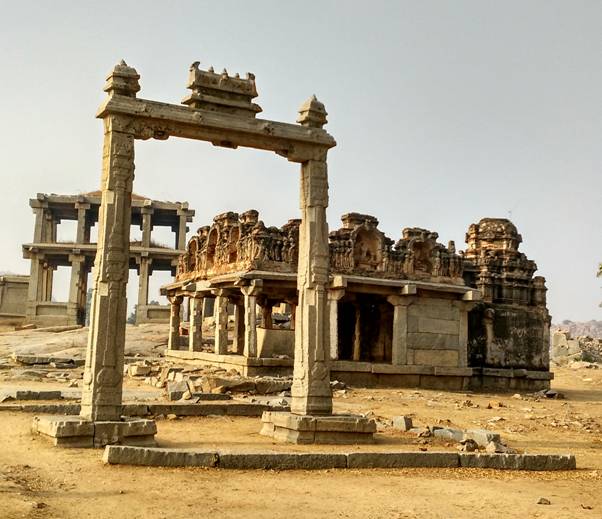The ruins at Hampi conjure images of an era gone by, of mighty dynasties who once ruled . Such are the vagaries of time. But the splendour of the structures remaining speak volumes of the past and the depict richness of Indian architecture which capture both the ordinary and the cosmic. In Hampi, Hospet in Karnataka’s Bellary district in present day Karnataka, there is a belief that this is the place of Kishkinda of Ramayana.
Archaeologically speaking, Bellary district has some rock edicts of King Ashoka. Buddhism was prevalent in the region in the first and second centuries A.D. The area has been ruled by Chalukyas of Badami, Rashtrakutas Chalukyas of Kalyani, the Hoysalas and the Yadavas.
Hampi, however conjures up images of the power and resplendence of the Vijayanagara kings. This empire came to glory after repeated Islamic invasions on South India. Harihara and Bukka from the Sangama dynasty founded the city of Vijayanagara with Hampi as the capital. Other dynasties too ruled over Vijayanagara empire; Saluva,Tulava, and Arivedu. Praudha Deva Raya(1420 – 60 A.D.) Krishnadevaraya(1509 – 1529) and Achyutaraya (1530 – 42 A.D.) are the well known rulers. The monuments, and shrines in Hampi include the Sasiva Kalu Ganesa, Vishnupada shrine, Kadale kalu Ganesa, temples on Hemakuta Hill, Virupaksha temple, manmatha Honda, Eduru Basavanna, Achyutaraya temple, Matanga Parvata, Kodandarama temple, Varaha temple, Siteya saragu, Sugriva’s cave, Kotilinga, Kampabhupa Marga, Hastagiri Ranganatha temple, Vishnu temple, Narasimha temple, Two storied mandapa and King’s balance, Purandara mandapa, and Vishnu temple. The building material used is the granite which abounds in the region. For domed structures and royal buildings stone rubble in mortar was used.
The most important temple in Hampi is the Vitthala temple dedicated to Vishnu. Other structures include Vitthala Bazaar and Loka Pavani, Kudure Gombe Mandapa, Gejjala Mandapa, siva temple, sri Naraharitirtha Brindavana, talavaraghatta gate, Prasanna narasimha temple, Krishna temple, Narasimha shrine, Badavi Linga uddana, Virabhadra, Chandikeswara temple, Lotus mahal, ruins of zenana enclosure, palace of Vira Harihara, Elephant’s stable, Guard’s house, Parswanatha temple, Ranga temple, Shringarada Habbagilu, Hazaara Ramachandra temple, Saraswati temple,Queen’s bath and many more…!
The most splendorous temple at Hampi is the Vitthala temple. Vitthala is a form of Lord Vishnu worshipped in Karnataka and Maharashtra. Vishnu has ten incarnations and sculptural representations are seen carved on various pillars of the temple. It is a huge temple complex and has entrance gateways on three sides. In the middle of the courtyard complex lies the main shrine. This was built before the sixteenth century. Devaraya II ( 1422-46 A. D.) most probably started the temple. Krishnadevaraya added many structures to it. The east facing temple has garbagriha,antarala,pradakshinapatha,sabhamandapa, mahamandapa, kalyanamandapa, and devi shrine for Rukmini, consort of Vitthala.The Vahana mandapa is the in the form of a chariot dedicated to Garuda, the vehicle of Lord Vishnu.The garbagriha and sabhamandapa are square shaped. The sabhamandapa stands on four central pillars which is set on a raised floor. The mahamandapa stands on 56 pillars.sculpted out of the granite stone elevated on an ornate base decorated with friezes which include horses horses with attendants and smaller shrines with ten incarnations of Vishnu. The ceiling is decorated with lotus and other motifs. The mahamandapa is supposedly having musical pillars. Pillars supporting the roof is supported by a pillar representing a musical instrument and is constructed as seven minor pillars around a main pillar. Thirty inscriptions have been found in the complex. The gopurams were donated by Chinna devi and Tirumala devi, queens of Krishnadevaraya who built the hundred pillar hall in 1516.

Vitthala temple, Hampi.
By Harish Aluru (Own work) [CC BY-SA 3.0 (https://creativecommons.org/licenses/by-sa/3.0)%5D, via Wikimedia Commons
Vitthala temple, Hampi.
By Dineshkannambadi (Own work) [CC BY-SA 3.0 (https://creativecommons.org/licenses/by-sa/3.0)%5D, via Wikimedia Commons

Musical pillars, Hampi.
Pic : Isha Vatsa
The Kalyanamandapa is an open mandapa standing on 48 pillars having three entrances, towards the southern side of the complex. The pillars depict the Dasavataras, Garuda, Hanuman, dancers and saints.

Kalyanamandapa, Vitthala temple, Hampi.
Pic : Isha Vatsa
The Uyalamandapa having two entrances is on the southern side which stands on 44 pillars. At the northern end sixteen pillars are raised and a wall has been constructed.
At north west side the devi shrine, dedicated to the consort of Vitthala is found which has a garbagriha, antarala, sabhamandapa and mukhamandapa. the sabhamandapa has a garbagriha attached to it. The pillars of sabhamandapa has deities on it. the mukhamandapa stands on 16 pillars which have deities on them.
The Vahana mandapa consists of a chariot- temple dedicated to Garuda, vehicle of Lord Vishnu. this is called vitthala ratha temple. It is believed that the world will end the day the chariot is moved from its place. The ratha is built in Dravidian style of architecture, on a rectangular base decorated with mythical scenes. the ratha has four heavy granite decorative stone wheels attached to it movable on axis shafts. in front the chariot has two elephants giving one the impression that they are pulling the chariot. it is believed that originally there were horses in the place of elephants. Between the elephants there is a ladder leading to the shrine.

Vitthala ratha, Hampi.
From a postcard on Hampi
On the southwest side a one hundred pillared hall, Nooru Kamba mandapa made by Krishnadevaraya with entrance towards east, is present.
Southwest to the Vitthala temple is the Tulapurushandana(King’s Balance) made up of two carved granite pillars with a granite lintel in between which has a stone loop in the centre. Scales were hung on special days and the Raya/king was weighed against gold or precious stones, which were given away in charity.

King’s balance, Hampi.
Pic : Isha Vatsa
References :
Temples of Hampi/K.M Suresh, Bharatiya Kala Prakashan,2003
Hampi : Monumental legacy ,Oxford University Press,2002
Hampi ruins : described and illustrated/A.H Longhurst,1917
Vijayanagara empire : ruins to resurrection, Raghu Rai and Usha Rai,Niyogi books,2014
Posted by :
Soma Ghosh
© author

